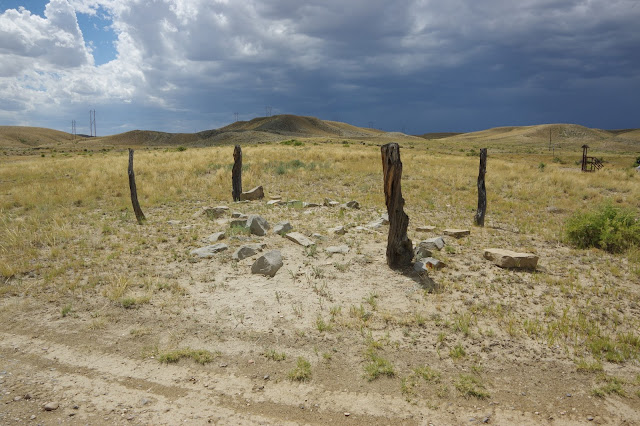Recently I was in Albany County and I stopped by a rest stop, just to visit the Lincoln Memorial, and found that the stop is jammed packed with memorials.
It has, of course, the Lincoln Memorial:
Abraham Lincoln Memorial, Interstate 80, Wyoming
It also has the Henry B. Joy Lincoln Highway Memorial:
This is the very large bronze of Abraham Lincoln located on Interstate 80 just east of Laramie, Wyoming. Interstate 80 is located on what was once the Lincoln Highway, hence explaining the very large bronze, which is otherwise somewhat unusual for a Wyoming monument.
Henry B. Joy Memorial, Interstate 80, Albany County Wyoming.And it has been designated the Purple Heart Trail:
This is a monument to one of the founders of the Lincoln Highway, located along its successor, Interstate 80. The art deco memorial was created in 1938, the "L" cement markers are markers for the Lincoln Highway that can be found here and there along its route.
While this blog started out with war memorials, it's covered quite a few trail markers over the years, and indeed I will now be adding that as a category here, meaning I have to go back and edit quite a few old posts. This marker, however, is only the second one I've posted on any of my blogs to highways, the other being the Black and Yellow Road near Gillette.
This marker is quite elaborate and very nice, being both a suitable marker for the Lincoln Highway and a nice example of an art deco piece of art.
Wyoming has also commemorated the highway, the noted individual, and the marker, with its own highway sign.
All of this is located at the same rest stop on Albany County that the Lincoln Memorial is located at. Of note, this marker was moved from its original location, which might have been one that was preferred by the individual commemorated by the marker.
Purple Heart Trail Memorial, Interstate 80, Albany County, Wyoming.And it also features a marker honoring ranching in Albany and Laramie Counties:
This monument is placed at the same rest stop that the Lincoln Memorial and the Lincoln Highway Memorial featured below are located. It's obviously in honor of those who have been wounded in action, and therefore eligible to receive the Purple Heart.
"Ranching from the high point" marker, Albany County, Wyoming.Does this seem like a bit much?
This is a marker dedicated to agriculture in Albany and Laramie Counties, Wyoming. It's located at the same rest stop that features the Lincoln Memorial, the Purple Heart Trail marker, and the Henry Bourne Joy marker.The final paragraph of this marker is quite true and highly significant. In this region of the country, environmentalist like to take pot shots at ranchers all the time, but if they weren't here, the wild spaces wouldn't be here either.
All of these monuments are fine, but in one single place? There was even one I didn't photograph. It's darned right crowded.
The Henry B. Joy monument, I'd note, was originally over by Rawlins, at a spot that Henry B. Joy liked. Maybe they should have left it near there. Maybe the Purple Heart Trail marker could be closer to Cheyenne? Anyway you look at it, this is a lot of markers in a concentrated amount of space. It risks diminishing them all, or so it seems to me.

































































































































